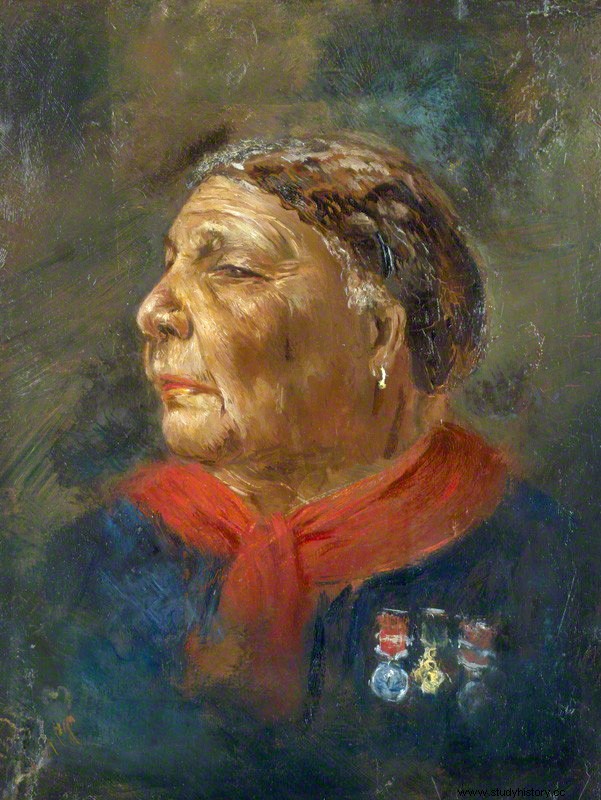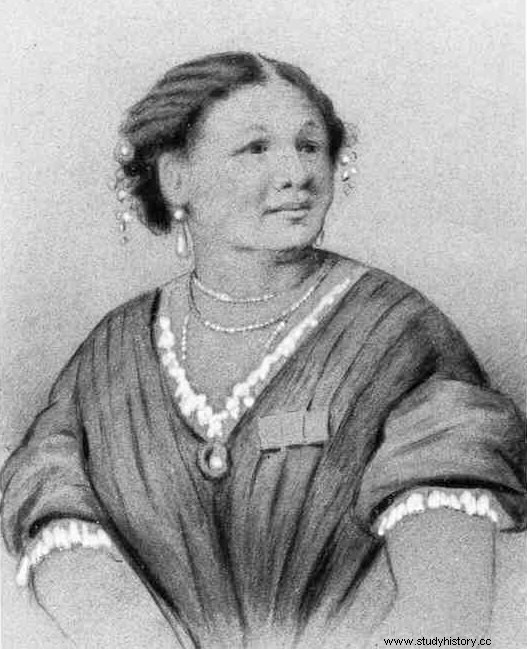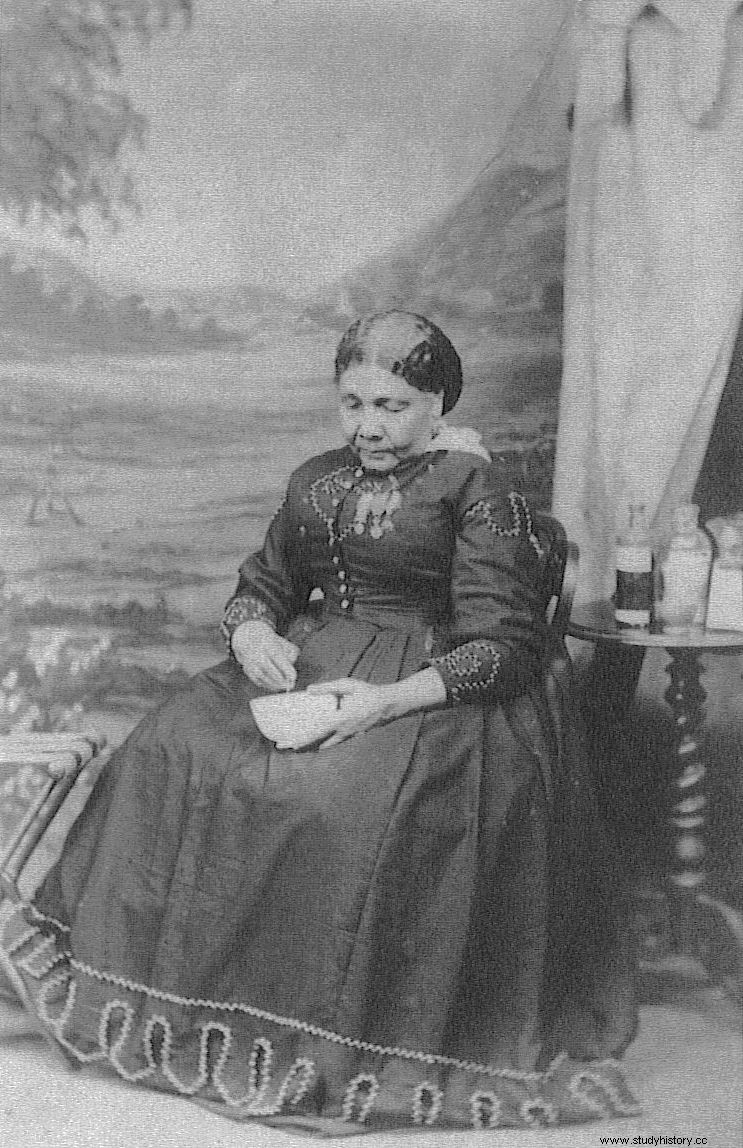Nurse Jamaican, Mary Seacole (1805 – 1881) volunteered her services during the Crimean War, but her request was rejected due to racial prejudice. She then made the 6,500 km journey alone and by her own means to the front.

An educated young woman
The daughter of a Jamaican healer and a Scottish officer in the British army, Mary Seacole was born in Kingston, Jamaica, in 1805. Running a boarding house largely frequented by soldiers and sailors, her mother used traditional African remedies and Caribbean to fight against yellow fever from which many of its residents suffer. Mary learns gradually, by her side, first by imitating her on her dolls and then by assisting her.
For a few years, Mary is engaged in the service of an elderly woman, who treats her like a member of her family and allows her access to education. At sixteen, she spent a year in London to visit members of her family; she will return there later, alone and without a protector, before returning to Jamaica in 1825. Mary spends some time with her sick boss to provide care for her, before returning to her mother.
Nurse and pension manager
Mary Seacole's nursing skills earned her occasional call-ups from the British Army Hospital, and travels to the Bahamas, Cuba, and Haiti. She perfected her knowledge of tropical fevers and traditional remedies. At the time, important events shook Jamaica:a slave revolt broke out in 1831, and the slaves were definitively emancipated in 1838.
In 1836, Mary married Edwin Horatio Hamilton Seacole, a merchant, who died eight years later. The couple's grocery store not meeting with success, Mary and her husband join the Grants' boarding house, Blundell Hall. In 1844, Edwin died, followed by Mary's mother. Overwhelmed, the young woman took refuge in work and took over the boarding house, rebuilt after a fire and named New Blundell Hall.
Cholera and yellow fever
 In 1850, an epidemic of cholera killed more than 32,000 Jamaicans. Mary Seacole treats many patients and is still developing her skills. These new skills will quickly be put to good use; when Mary visits her half-brother Edward in Cruces (now Panama), a cholera epidemic strikes the town. It is she who treats the first victim, who survives cholera; the patients then flock, and Mary treats the rich, who pay, and the poor for free. The losses will be many. Mary herself contracts cholera, but she survives it.
In 1850, an epidemic of cholera killed more than 32,000 Jamaicans. Mary Seacole treats many patients and is still developing her skills. These new skills will quickly be put to good use; when Mary visits her half-brother Edward in Cruces (now Panama), a cholera epidemic strikes the town. It is she who treats the first victim, who survives cholera; the patients then flock, and Mary treats the rich, who pay, and the poor for free. The losses will be many. Mary herself contracts cholera, but she survives it.
In Cruces, Mary opens a hotel that she runs for a while before returning to Jamaica. On her return, the Jamaican medical authorities called on her to treat the victims of yellow fever. Not content with putting her skills at the service of the sick, Mary organizes a nursing service by mainly soliciting Afro-Caribbean healers. In 1854, she returned to Panama.
The Crimean War and Florence Nightingale
The same year, the Crimean War broke out; it pits the Russian Empire against an alliance of the Ottoman Empire, France, the United Kingdom and the Kingdom of Sardinia. Among the thousands of soldiers sent to the field, hundreds contract cholera, as well as other diseases; with only a few poorly equipped and understaffed hospitals, many die.
It is in this context that Florence Nightingale put together a team of 38 volunteer nurses to go to Crimea and reinforce the war hospitals. Convinced that her experience during cholera epidemics could be useful, Mary Seacole travels to London and tries to be sent to Crimea. Despite her experience, she fails to get an interview and quickly realizes that she is a victim of racism, and that her skin color and age do not meet Florence Nightingale's criteria.
Determined not to be stopped by these refusals, Mary travels to Crimea alone and on her own resources. As she has already done in Panama, she plans to open a boarding house there with quarters for the wounded and sick. On the way, Mary meets Florence Nightingale in Istanbul and, letter of recommendation in her pocket, renews her offer to work for her. She receives a new refusal.
In Crimea
Arrived in the Crimea, Mary Seacole built her hotel by reusing abandoned wood and metal, boxes, steel sheets, windows and salvaged doors. She opens her British Hotel in March 1855, and quickly received its first visitors. In addition to the lodge, Mary sells provisions and equipment to passing guests, serves meals, provides medical care and conducts medical rounds.
Mary makes a habit of selling or distributing supplies around soldier camps and the battlefield. Known by the nickname of "Mother Seacole" by the British soldiers, she lavishes her care on the battlefield, alleviates the suffering of the wounded, cares for free those who cannot pay. His outings on the battlefield, under enemy fire, earned him the dislocation of his thumb, an injury that will never fully recover.
When the Crimean War ended in 1856 and the armies left, Mary found herself in a delicate financial situation, with supplies that no longer found buyers and that she had to sell at a loss. When she returns to England, she is ruined and sued by her creditors.

Difficult financial situation
Mary Seacole's financial difficulties are reported in the British press, triggering fundraising for her benefit. Florence Nightingale, who in Crimea accused him of leading a bad life and told his nurses to keep their distance, is taking part in the collection. The funds raised make it possible to settle Mary's debts, but she remains destitute. A difficult financial situation which prevents him, in particular, from going to India to help the wounded of the revolt of the Sepoys of 1857.
In 1857, Mary published her autobiography under the title The Extraordinary Adventures of Mrs. Seacole in many countries . She mainly recounts her years in Panama and her experience during the Crimean War. Written by William Howard Russel, the preface reads:
"I witnessed her devotion and courage...and I hope England will never forget her who fed her sick, who sought to bring aid and succor to her wounded, and who performed last services for some of his illustrious dead"
End of life in London
Mary Seacole returns to Jamaica for a few years, but again faces financial difficulties. In London, the Seacole Foundation is organizing a new collection to buy him land in Kingston.
In 1870, Mary moved to London, where she notably became the personal masseuse of the Princess of Wales. She died in 1881; the fame he enjoyed at the time of his death does not survive him. Mary Seacole is largely overshadowed in memory by Florence Nightingale. In 1991, Jamaica posthumously awarded him the Jamaican Order of Merit. Since the 2000s, its actions and history have again been recognized in the United Kingdom; in March 2005, a Mary Seacole exhibition celebrated the bicentenary of her birth at the Florence Nightingale Museum in London.
